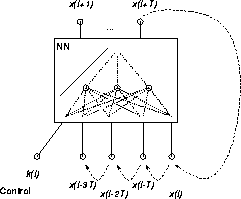
There are different topologies of neural networks that may be employed for time series modeling. In our investigation we used radial basis function networks which have shown considerably better scaling properties, when increasing the number of hidden units, than networks with sigmoid activation function. As proposed by Verleysen et. al [8] we initialize the network using a vector quantization procedure and then apply backpropagation training to finally tune the network parameters. The tuning of the parameters yields an improvement factor of about ten in prediction error compared to the standard RBF network approach [2].
The resulting network function for m-dimensional vector valued output is of the form
where  stands for the standard deviation of the Gaussian,
the input
stands for the standard deviation of the Gaussian,
the input  and the centers
and the centers  are n-dimensional
vectors and
are n-dimensional
vectors and  and
and  are m-dimensional parameters of
the network. Networks of the form eq. (2) with a finite number
of hidden units are able to approximate arbitrary closely all
continuous mappings
are m-dimensional parameters of
the network. Networks of the form eq. (2) with a finite number
of hidden units are able to approximate arbitrary closely all
continuous mappings  [3]. This
universal approximation property is the foundation of using neural
networks for time series modeling, where they are referred to as
neural models. In the context of the previous section the neural
models are approximating the systems prediction function.
[3]. This
universal approximation property is the foundation of using neural
networks for time series modeling, where they are referred to as
neural models. In the context of the previous section the neural
models are approximating the systems prediction function.
To be able to represent instationary dynamics, we extend the network to have an additional input, that enables the control of the actual mapping
From the universal approximation properties of the RBF-networks stated
above it follows, that eq. (3) with appropriate control
sequence  is able to approximate any sequence of functions. In
this setting i represents the sample time. The control sequence may
be optimized during training [1] or, with lower
computational demands, may be appropriately chosen in advance.
Selecting
is able to approximate any sequence of functions. In
this setting i represents the sample time. The control sequence may
be optimized during training [1] or, with lower
computational demands, may be appropriately chosen in advance.
Selecting  to be monotonically increasing with i will often
work, as long as the number of training samples is high enough to fix
the different network functions. In our investigation we select
to be monotonically increasing with i will often
work, as long as the number of training samples is high enough to fix
the different network functions. In our investigation we select
 to be a linear, increasing function of i.
to be a linear, increasing function of i.

Figure 1:
Input/Output structure of the neural model.